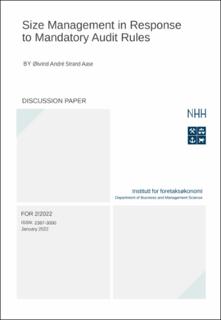Size Management in Response to Mandatory Audit Rules
Working paper

Åpne
Permanent lenke
https://hdl.handle.net/11250/2836710Utgivelsesdato
2022-01-10Metadata
Vis full innførselSamlinger
- Discussion papers (FOR) [566]
Sammendrag
Many countries have introduced thresholds for mandatory audits as a measure of reducing complexity and costs for private firms’ financial reporting. Firms around the size thresholds have incentives to size down in order to avoid audit costs when the perceived benefits of audit are smaller than the costs. Norway was the last country in the EU/EEA to have a fully regulated audit market for all limited liability firms. Using panel data from this institutional setting, I find clear evidence of change in the size distribution of firms around the revenue threshold after the audit reform. I find that the firms that avoid audit save external services fees by an amount comparable to their estimated lost profits. This suggests that also indirect audit costs, such as management time, play a part in the cost-benefit assessment of audits. I find no significant evidence of firms using real earnings management as a mechanism for size management. This implies that firms stay below the audit threshold through other forms of size management, such as foregoing short term growth opportunities. Total revenue lost due to revenue management in years affected by the audit-reform is, however, estimated to be immaterial.